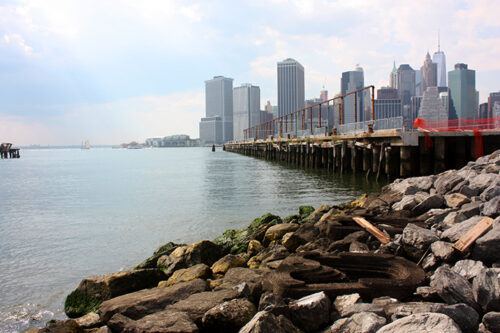As part of Climate Week NYC, the Waterfront Alliance hosted a webinar highlighting projects that have shaped New York Harbor with resilient, accessible designs recognized by the Waterfront Edge Design Guidelines (WEDG). The webinar was hosted by the Chief Waterfront Design Officer of the Waterfront Alliance, Joseph Sutkowi, and Domenica Stasiak, a Partner at Indigo River.
Waterfront Alliance developed WEDG, a science-based rating system and set of rigorous guidelines for projects, to address the waterfront development challenges of coastal resilience, public access, and ecology and habit. WEDG is a tool that recognizes ecosystem and community services not normally valued in waterfront development.
Along with an overview of each WEDG standard, Domenica described projects across New York exemplifying these principles, specifying ECOncrete as a beneficial structural and ecological technology to use in coastal protection measures.
Domenica mentioned ECOncrete as she spoke about the Brooklyn Bridge Park renovation, a project that exemplifies innovative approaches to edge resilience and natural resources. The waterfront was once a series of ports, with warehouse structures that remained until 2008. It transformed into a large park containing 2 beaches, softer coasts, and piles repaired with ECOncrete. She remarked that the use of ECOncrete technology was “really great because ordinary concrete does not allow for growth and we’re losing the space for habitat. The more habitat we have, the better for the environment.”
Other projects to highlight (among many others of interest) include the Bronx Point project and Hunter’s Point South project. In the Bronx, multiple stakeholders came together to transform unused land into a site of ecological coastal resilience, public space, affordable housing, and community education. Similarly, Hunter’s Point South used to be storage then a parking lot, and now provides affordable housing, public amenities, and walking areas that function as flood protection.
An underlying theme of all of the recognized projects is the incorporation of eco-engineering of necessary infrastructure itself. When answering a question about structurally sound nature based solutions in WEDG projects, Joseph said that ECOncrete is “growing a lot in popularity, in part because of its ecological features and part because of its versatility. It’s a structural concrete, so it has the same strength and other properties that the standard concrete would have, just with all these added benefits.”
Watch the full webinar here:
Webinars hosted by ECOncrete:

